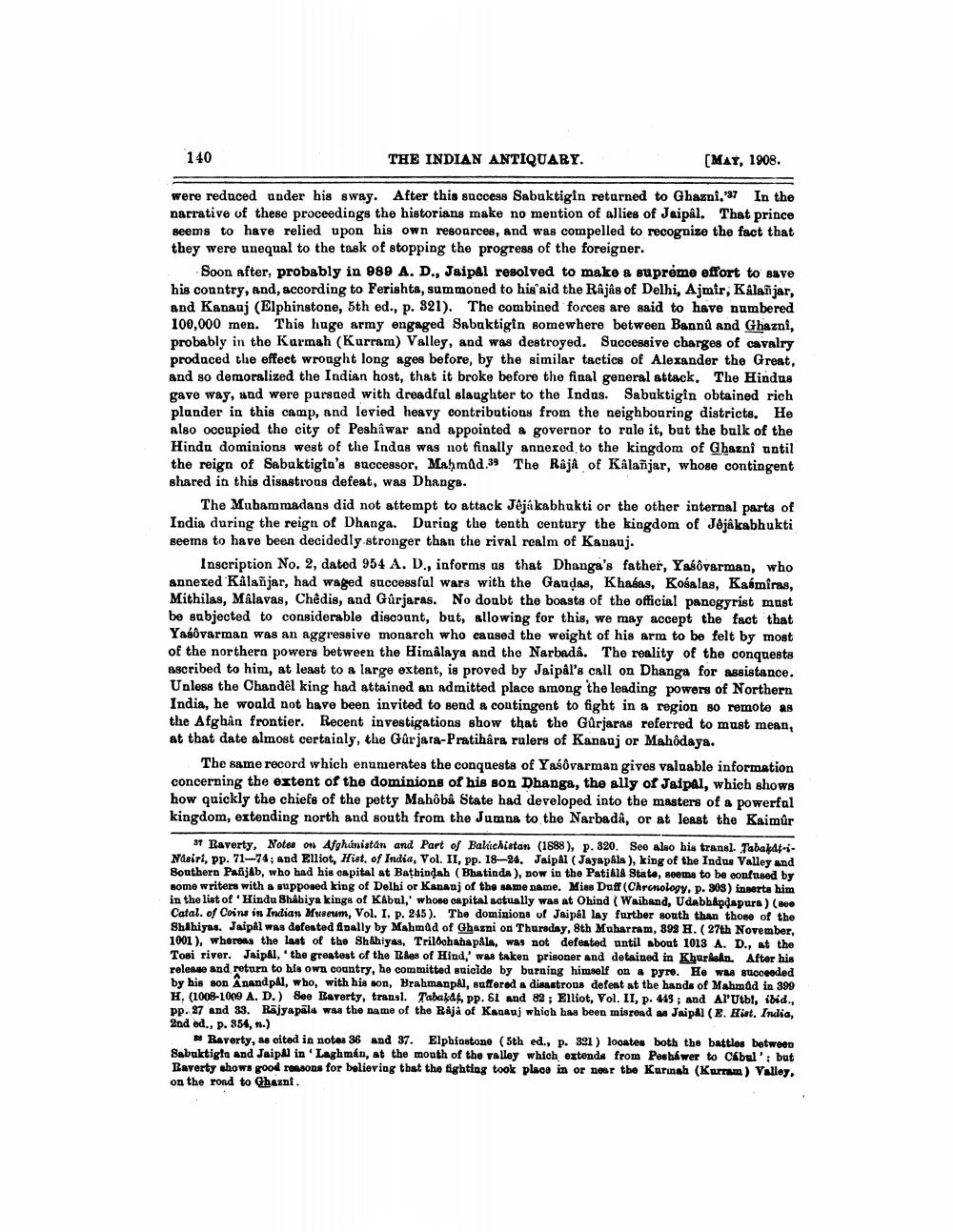________________
140
THE INDIAN ANTIQUARY.
(MAY, 1908.
were reduced under his sway. After this success Sabuktigin returned to Ghazni,"37 In the narrative of these proceedings the historians make no mention of allies of Jaipal. That prince seems to have relied upon his own resources, and was compelled to recognize the fact that they were unequal to the task of stopping the progress of the foreigner.
Soon after, probably in 989 A. D., Jaipal resolved to make a supreme effort to save his country, and, according to Ferishta, summoned to his'aid the Rajâs of Delhi, Ajmir, Kalajar, and Kanaaj (Elphinstone, 5th ed., p. 321). The combined forces are said to have numbered 100,000 men. This huge army engaged Sabaktigin somewhere between Bannů and Ghazni, probably in the Kurmah (Kurram) Valley, and was destroyed. Successive charges of cavalry produced the effect wrought long ages before, by the similar tactics of Alexander the Great, and so demoralized the Indian host, that it broke before the final general attack. The Hindus gave way, and were pursued with dreadful slaughter to the Indus. Sabuktigin obtained rich plander in this camp, and levied heavy contributions from the neighbouring districts. He also occupied the city of Peshawar and appointed a governor to rule it, but the bulk of the Hindu dominions west of the Indas was not finally annexed to the kingdom of Ghazni until the reign of Sabaktigio's successor, Mahmûd.39 The Raja of Kalañjar, whose contingent shared in this disastrous defeat, was Dhanga.
The Muhammadans did not attempt to attack Jéjá kabhukti or the other internal parts of India during the reign of Dhanga. During the tenth century the kingdom of JojAkabhukti seems to have been decidedly stronger than the rival realm of Kanauj.
Inscription No. 2, dated 954 A. D., informs as that Dhanga's father, Yaśôvarman, who annexed Kalañjar, had waged successful wars with the Gaudas, Khabas, Kosalas, Kasmiras, Mithilas, Mâlavas, Chedis, and Gurjaras. No doubt the boasts of the official panogyrist must be subjected to considerable discount, but, allowing for this, we may accept the fact that Yasovarman was an aggressive monarch who caused the weight of his arm to be felt by most of the northern powers between the Himalaya and the Narbada. The reality of the conquests ascribed to him, at least to a large extent, is proved by Jaipal's call on Dhanga for assistance. Unless the Chandel king had attained an admitted place among the leading powers of Northern India, he would not have been invited to send a contingent to fight in a region to remote as the Afghân frontier. Recent investigations show that the Gürjaras referred to must mean, at that date almost certainly, the Gurjara-Pratibâra rulers of Kananj or Mahôdaya.
The same record which enumerates the conquests of Yaśðvarman gives valuable information concerning the extent of the dominions of his son Dhanga, the ally of Jaipal, which shows how quickly the chiefs of the petty Mahoba State had developed into the masters of a powerful kingdom, extending north and south from the Jumna to the Narbadâ, or at least the Kaimur
31 Raverty. Notes on Afghanistan and Part of Baluchistan (1888), p. 320. See also his transl. Tabakdf-sNasiri, pp. 71-74; and Elliot, Hist. of India, Vol. II, pp. 18-24. Jaipal (Jayapaila ), king of the Indus Valley and Southern Pafijab, who had his capital at Bathindah (Bhatinda), Dow in the PatiALA State, seems to be confused by some writers with a supposed king of Delhi or Kananj of the same name. Miss Duff (Chronology, p. 308) inserts him in the list of Hindu Shâbiya kings of Kabul,' whose capital actually was at Ohind (Waihand, Udabb&pdapura) (ne Catal. of Coins in Indian Museum, Vol. I. p. 245). The dominions of Jaipal lay further south than those of the Shihiyas. Jaipal was defeated finally by Mahmud of Ghazni on Thursday, 8th Muharram, 892 H. ( 27th November, 1001), whereas the last of the Shahiyas, Trilochaha påla, was not defeated until about 1013 A. D., at the Tosi river. Jaipal, the greatest of the Ries of Hind,' was taken prisoner and detained in Khursan. After his release and return to his own country, he committed suicide by burning himself on a pyro. He was succeeded by his son Anandpal, who, with his son, Brahmanpal, suffered a disastrous defeat at the hands of Mahmad in 399 H. (1008-1019 A. D.) See Raverty, transl. Tabakas pp. 61 and 82 ; Elliot, Vol. II, p. 449 ; and Al'Utbl, ibid., pp. 27 and 33. Rajyapals was the name of the Raja of Kazauj which has been misread as Jaipůl (E. Hist. India, 2nd ed., p. 854, ..)
# Raverty, as cited in notes 36 and 37. Elphinstone (5th ed., p. 321 ) locates both the battles between Sabuktigta and JaipA) in Laghman, at the mouth of the valley which extends from Peebawer to Cebul': but Baverty shows good reasons for believing that the fighting took place in or near the Karinah (Kurrum) Valley, on the rond to Ghazni.




